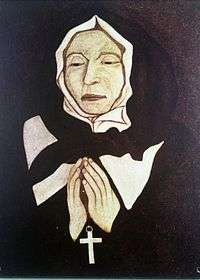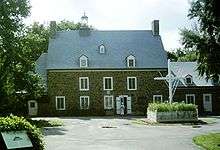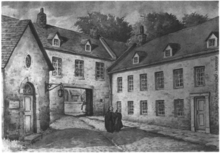Congregation of Notre Dame of Montreal

The Congrégation de Notre Dame is a religious community for women founded in 1658 in the colony of New France, now part of Canada. It was established by Marguerite Bourgeoys, who created a religious community for women where the sisters were not confined to a convent but were allowed to live among and help the less fortunate.[1] The Congregation held an important role in the development of New France, as it supported women and girls in the colony and offered roles for them outside the home. It founded a boarding school for girls' education, watched over the filles du roi, women immigrants whose passage was paid by the Crown to stimulate development of families in the colony, and served as missionaries to the Aboriginal people.[2] The community's motherhouse has been based in Montreal for over 350 years. Marguerite Bourgeoys was canonized in 1982 by the Roman Catholic Church as Canada's first woman saint.
Origins of the Congregation
The Congrégation Notre-Dame was a previously well funded women's religious order created in France by Pierre Fourier and Alix Le Clerc; it was committed to education through the organization of the Catholic Church.[3] Bourgeoys joined the externe Congregation following a great spiritual experience in 1640 and a long search for a place within the more conventional contemplative women's religious communities. As Bourgeoys helped in the Congregation of Notre Dame, she had a vision of a new kind of religious community for women. This new order took Mary, the mother of Jesus, as their role model, considering her to be an actor in the Bible together with Jesus and his apostles. Bourgeoys wanted the women of her new order to be active and among those who needed their help, and not cloistered in a convent waiting for the needy to come to them.[4]
This vision, together with her experience in teaching and working in the Congregation of Notre Dame in Troyes, France and an invitation by Paul de Chomedey de Maisonneuve, inspired Bourgeoys to head to New France. There in 1657 she established an educative/proselytizing order for women: the Congregation of Notre Dame. The Congregation received civil recognition in 1671 from King Louis XIV and finally was granted official status by the Catholic Church in 1698: some 40 years after its creation and only two years before the death of Marguerite Bourgeoys.
Location
By 1665, the Congregation consisted of Bourgeoys and three other sisters living in Montreal; they taught in a stone building known as the "stable school" established in 1658.[5] The Convent was near the corner of Notre-Dame and Saint Paul Street, in what is now called Old Montreal. As revealed by its architectural plans, the early convent was a private space, secluded from the public life of Montreal. The convent was placed deeply within its own terrain, and its separation from public life was protected by the Hôtel Dieu and the walls that surrounded it.[6] The sisters were provided protection and seclusion whilst surrounded by the colony's merchants and more rowdy inhabitants, such as soldiers and labourers.

Maison Saint-Gabriel
In 1668, Bourgeoys purchased the Maison Saint-Gabriel outside Montreal: a farm property which the sisters of the Congrégation de Notre-Dame operated for nearly 300 years. It was temporary home for some of the King's Wards, also called the King's Daughters, or Filles du Roi. On the property, the sisters produced food and products to support the Congrégation de Notre-Dame, new settlers and others in need.
Today the property has been developed as a living museum of farming and historic times. The property, outbuildings and grounds have been restored and expanded, and the museum houses some 15,000 artifacts recreating the feel of the house from the 17th and 18th century.[7]
Controversy of the uncloistered
The difficulties of establishing a non-cloistered religious order for women in 17th century New France were considerable. At the time, such independent action by women threatened some men, and the church preferred the regimen of the cloistered nun behind the walls of a convent.[8] Marguerite and the sisters of the Congrégation de Notre-Dame broke this mold. Before 1698, the first two bishops of Quebec, François de Laval and Jean-Baptiste de La Croix de Chevrières de Saint-Vallier, were ambivalent about the Congregation, failing to understand their need to remain uncloistered. However, they did recognize the societal need for traveling teachers; they counted on Bourgeoys and her sisters to reach the small and dispersed population of Canada in these early years. The sisters were allowed to live a relatively uncloistered life. They were needed to take education to the children between Quebec and Montreal and beyond. If women were to be the educators, Laval and Saint-Vallier reluctantly recognized the sisters needed to be able to travel and live outside a convent.[4]
By 1694 Bishop Saint-Vallier sent the Congregation a new constitution that imposed more restrictions. The sisters had enjoyed certain freedoms for approximately forty years, and resisted more restrictive and conventional rules.[9] The constitution afforded the Congregation the right to officially declare vows, necessary to gain legitimacy in the frontier society and grow as an organization. It required the sisters to be obedient to and report directly to the bishop of Quebec. The document also required them to take solemn vows, attacked their more secular activities in the convent, and instituted the requirement of a dowry to be donated by new sisters. After a few years of resistance, in 1698 the sisters had to accept Saint-Vallier's constitution; it had traditional requirements long enforced in Europe. Cloistering was a tradition used to safeguard the chastity of women religious, as well as to encourage a more prayerful way of life.
After Saint-Vallier's constitution
The nuns were to take vows, including a traditional one of stability. This meant that women could not leave the convent at will. The constitution created a hierarchical divide, also traditional, between the women who had taken their vows and those who had not. The bishop imposed payment of a dowry by new recruits. In practice, it prevented attracting women of the lower classes, whose families generally did not have money to contribute.
While the new constitution enforced more traditional conditions, the sisters of the CND maintained some seventeenth-century practices. Many of them continued to teach, travel and lend their expertise to other parishes across New France.
Role of Congregation Sisters in the Edcaucation of Women and Ile Royale
Schools were essentially administered by the Church, eighteenth-century formal education focused on behavioural aspects, it was about having a civilized Christian population, Cultivation of the human heart was the first step in the education process. Christian moral principles were taught to the kids who attented religious schools in New France.[10] Nearly all the teachers in New France belonged to the clergy, as evidenced by the 1727 ordinance issued in Canada. This document stated that all teachers in the colony needed approval from the Bishop of Quebec. Teacher's methods and material were closely monitored by their parish's priest.[11]
The formal education system on the colony of Ile Royale was however non-existent. Founded in 1713, Ile Royale was located in areas of the Canadian provinces of Nova Scotia and Prince Edward Island. While preparing the colony's establishment in 1713, the minister of the marine never once discussed the establishment of schools. They believed that the Récollets missionaries would open colonial parish schools. By the mid 1720s, there were still no established schools in a small but significant community of over 300 children.[12] Conflicting opinions between local and royal officials lead locals to take the matter of education into their own hands. Imperial officials refused the commisonnaire-ordonnateur Mézy's demand to establish a public catholic school in Louisbourg.
Concerned about the ethic and moral teaching of girls, Mézy and other local officials turned to Montreal's Congrégation Notre Dame.The comissionaire-ordonnateur suggested that a delegation of religious sisters from the Congrégation should be sent to help educate girls. Finally in 1727 Marguerite Roy and two sisters were sent from Montreal to oversee the teaching of girls in the colony.Very shortly after arriving they established a school and took 22 girls under their wing.The bishops of Quebec saw this as an urgent cause , particularly Bishop Saint-Vallier showed great concern about the moral instruction and upbringing of girls raised in the colony.[12] However, financial difficulties complicated their task, as they needed to purchase a house in which they would teach. While successful, Roy was unable to pay her debts and accused of fraud , she was sent back to Montreal in 1733 and replaced by three sisters lead by Marguerite Trottier. The sisters sold straw pallets to soldiers in order to supplement their income. On the other hand, the religious brothers were much wealthier, and their teaching benefitted from more resources and superior infrastructure. Ile Royale was a poor religious community, low income, debt and budget issues were a consistent problem for the sisters of the Congrégation Notre-Dame well into 1753.[13]
Despite the restricted the number of girls admitted by the sisters, many girls from the colony of Ile Royale were instructed successfully by sisters from the Congrégation Notre-Dame. Consistent with the era, instruction in morality and Christian ethics remained more important than education in reading and writing. Both female day students and boarders benefitted from the school. Despite religious obligations mandatory in all parish run schools in New France, religious texts permitted girls to learn how to read and write. Some math was also taught, although limited.[14] The education given to girls under the sisters of Congrégation Notre-Dame in Ile Royale was considered adequate by the standards of the era. Students of the school had to follow a consistent weekly schedule.
Notable sisters of the Congregation of Notre Dame
See also
References
- ↑ Simpson (2005), p. 5.
- ↑ Dumont, Micheline (2004). "Congrégation de Notre-Dame," in The Oxford Companion to Canadian History, ed. Gerald Hallowell. Oxford: Oxford University Press. Oxford Reference Online.
- ↑ Simpson, (2005), p. 6.
- 1 2 Simpson (2005), p. 6.
- ↑ Gray (2007), p. 4.
- ↑ Gray (2007), p. 18.
- ↑ "History" Archived February 9, 2012, at the Wayback Machine., Maison Saint-Gabriel website, accessed 6 Feb 2010
- ↑ Greer, Allan (1997). The People of New France. Toronto: University of Toronto Press. pp. 72–73.
- ↑ Gray (2007), p. 19.
- ↑ Crowley, Terry (1985). "Religion in New France:Church and State in Louisbourg". Proceedings of the Meeting of the French Colonial Historical Society. 10: 140.
- ↑ Johnston, A.J.B (1984). Religion in Life at Louisbourg. McGill-Queen's University Press,. p. 87.
- 1 2 Johnston, A.J.B (1984). p. 88. Missing or empty
|title=(help) - ↑ Crowley, Terry (1985). : 143. Missing or empty
|title=(help) - ↑ Johnston, A.J.B (1984). pp. 102–104. Missing or empty
|title=(help)
- Gray, Colleen (2007). The Congrégation de Notre-Dame, Superiors, and the Paradox of Power, 1693-1796. Montreal: McGill-Queen's University Press
- Simpson, Patricia (2005). Marguerite Bourgeoys and the Congregation of Notre Dame, 1665-1700. Montreal: McGill-Queen's University Press
External links
- Congregation of Notre Dame - Official website
- Schola Ministries - A CND Ministry
